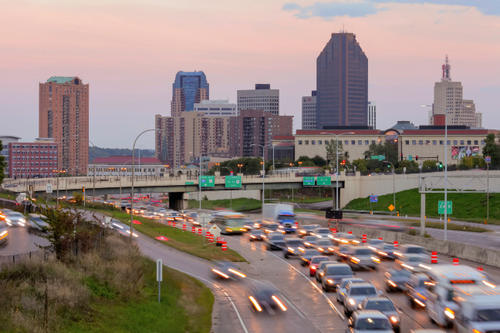Nationwide study finds big differences in effects of congestion on access to jobs by car

Annual nationwide data from the Accessibility Observatory at the University of Minnesota revealed significant differences among major U.S. cities in how well they are coping with the congestion.
According to the Access Across America: Auto 2018 study, the Minneapolis–St. Paul metro area ranked sixth in terms of job accessibility but 28th in the reduction in job access due to congestion. In fact, Minneapolis–St. Paul this year edged above the much-larger Houston, which ranks seventh and has a million more jobs.
“Every year I look at these results, it’s stunning how well Minneapolis–St. Paul does in making it easier to get to work compared to other major U.S. metros,” says Andrew Owen, director of the Observatory. “We have a well-designed and well-managed transportation network that connects people to lots and lots of jobs.”
By contrast, Philadelphia ranks sixth nationally in total jobs but ranks 13th in access to those jobs and in congestion delays. The Boston metro, which ranks 10th in total jobs, also faces significant challenges, ranking fifth in congestion delays and 17th in accessibility.
The rankings focus on accessibility, a measure that examines both land use and transportation systems. Accessibility measures how many destinations, such as jobs, can be reached in a given time.
Key factors affecting the rankings for any metro area include:
- the number of jobs available and where they are located;
- the road network structure, traffic management practices;
- the provision of alternate transportation modes;
- and, population size, density, and location.
Better coordination of transportation systems with the location of jobs and housing will improve job accessibility by auto.
The findings have a range of uses and implications. State departments of transportation, metropolitan planning organizations, and local government agencies can apply the evaluations to performance goals related to congestion, reliability, and sustainability. In addition, detailed accessibility evaluation can help in selecting between project alternatives and prioritizing investments.
The annual study, part of the Access Across America study that began in 2013, ranks the 50 largest (by population) metropolitan areas in the United States for connecting workers with jobs by auto and measures the delay getting to those jobs due to traffic congestion. Cars, trucks and other private motor vehicles are used for an estimated 86 percent of commuting trips in the United States, making it the most widely used commute mode.
Rankings of the top 10 metro areas for job accessibility by auto in 2018 changed only slightly from the previous year, with Los Angeles, New York, and Dallas topping the list.
This year’s report also includes detailed block-level maps that illustrate the spatial patterns of accessibility within each area.
The research is sponsored by the National Accessibility Evaluation Pooled-Fund Study, a multi-year effort led by the Minnesota Department of Transportation and supported by partners including the Federal Highway Administration and 12 additional state DOTs.
The Accessibility Observatory at the University of Minnesota is the nation’s leading resource for the research and application of accessibility-based transportation system evaluation. The Observatory is a program of the Center for Transportation Studies, a national leader in fostering innovation in transportation.
Media Notes
The research report Access Across America: Auto 2018 will be published and available for download at 9:00 a.m. CDT on April 15, 2020.
Detailed interactive color maps illustrating the jobs accessible by auto in each metro area are available on the study web page. The Auto 2018 report and other Access Across America research reports for auto and transit are available at access.umn.edu.
- Categories:
- Science and Technology





